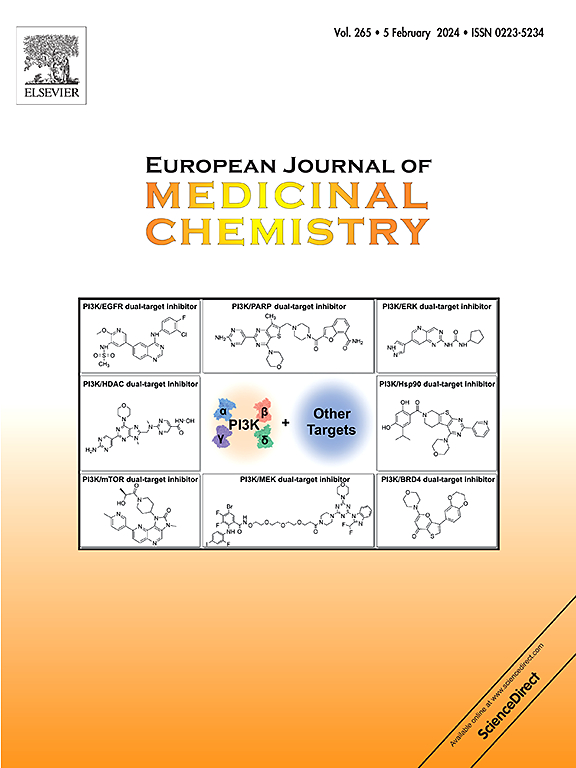Peptide inhibitors: Breaking cancer code
IF 6
2区 医学
Q1 CHEMISTRY, MEDICINAL
引用次数: 0
Abstract
Tumour signalling pathways play a pivotal role in tumorigenesis by controlling key cellular processes, including growth, proliferation, metastasis, and survival. Conventional treatments like chemotherapy often face limitations such as non-specific toxicity and drug resistance. Peptide inhibitors have gained attention as a promising therapeutic alternative due to their high selectivity in disrupting oncogenic pathways via protein-protein interactions (PPIs) and ligand binding. Currently, two out of 31 peptide-based cancer drugs have demonstrated signalling inhibition, with several others under investigation. However, challenges related to stability, delivery, and resistance persist, prompting innovations in peptide design, such as cyclisation and nanoparticle-based delivery systems. This review examines strategies to enhance peptide drug efficacy, explores the mechanisms by which peptide inhibitors target key pathways like the rat sarcoma protein (RAS) and mammalian target of rapamycin (mTOR) pathways, and highlights ongoing research on peptide-based interventions. Key examples include RAS-targeting peptides such as KRpep-2D, cyclo-CRVLIR, L5UR, RAS-binding peptide (RBP), the mutant KRAS peptide vaccine combined with Nivolumab and Ipilimumab, cyclorasin B4-27, and LUNA18, as well as mTOR-targeting peptides like P1_WT, PDHK1-241aa, TRIM1-269aa, and the micropeptide human small regulatory polypeptide of amino acid response (hSPAR). Among these, the mutant KRAS peptide vaccine (with Nivolumab and Ipilimumab) and LUNA18 demonstrate promising clinical potential and are currently undergoing trials.


肽抑制剂:打破癌症密码
肿瘤信号通路通过控制关键的细胞过程,包括生长、增殖、转移和存活,在肿瘤发生中起关键作用。化疗等传统治疗方法往往面临非特异性毒性和耐药性等局限性。肽抑制剂由于其通过蛋白-蛋白相互作用(PPIs)和配体结合破坏致癌途径的高选择性,作为一种有前景的治疗选择而受到关注。目前,31种基于肽的癌症药物中有两种已经证明了信号抑制作用,还有其他几种正在研究中。然而,与稳定性、递送和抗性相关的挑战持续存在,促使肽设计的创新,如环化和基于纳米颗粒的递送系统。本文综述了提高多肽药物疗效的策略,探讨了多肽抑制剂靶向关键通路如大鼠肉瘤蛋白(RAS)和哺乳动物雷帕霉素靶点(mTOR)通路的机制,并重点介绍了正在进行的基于多肽的干预研究。主要的例子包括ras靶向肽,如KRpep-2D、环- crvlir、L5UR、ras结合肽(RBP)、突变体KRAS肽疫苗联合Nivolumab和Ipilimumab、cyclorasin B4-27和LUNA18,以及mtor靶向肽,如P1_WT、PDHK1-241aa、TRIM1-269aa,以及人氨基酸反应小调控多肽(hSPAR)。其中,KRAS突变肽疫苗(联合Nivolumab和Ipilimumab)和LUNA18显示出良好的临床潜力,目前正在进行试验。
本文章由计算机程序翻译,如有差异,请以英文原文为准。
求助全文
约1分钟内获得全文
求助全文
来源期刊
CiteScore
11.70
自引率
9.00%
发文量
863
审稿时长
29 days
期刊介绍:
The European Journal of Medicinal Chemistry is a global journal that publishes studies on all aspects of medicinal chemistry. It provides a medium for publication of original papers and also welcomes critical review papers.
A typical paper would report on the organic synthesis, characterization and pharmacological evaluation of compounds. Other topics of interest are drug design, QSAR, molecular modeling, drug-receptor interactions, molecular aspects of drug metabolism, prodrug synthesis and drug targeting. The journal expects manuscripts to present the rational for a study, provide insight into the design of compounds or understanding of mechanism, or clarify the targets.

 求助内容:
求助内容: 应助结果提醒方式:
应助结果提醒方式:


